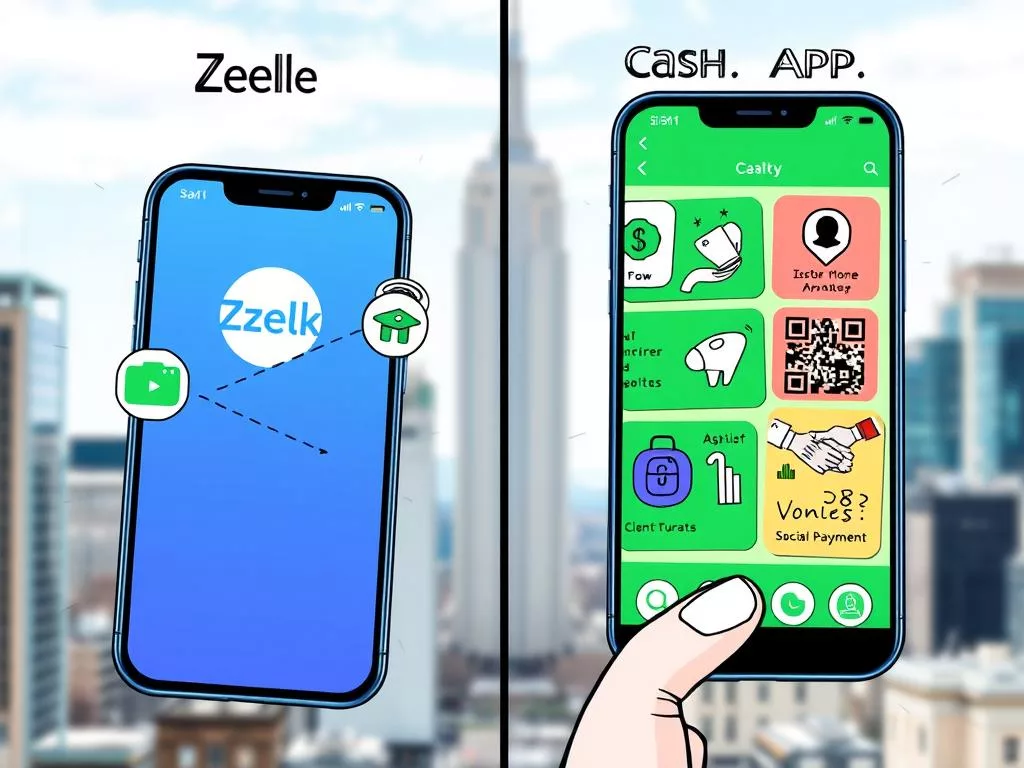In today’s digital world, Zelle and Cash App are two big names in peer-to-peer payments. They make sending money easy but have different features for various needs. This guide will compare Zelle and Cash App, looking at how they work, their user interfaces, and what they can do.
Cash App started in 2013 and has grown fast. It lets users send money easily and even buy Bitcoin and stocks. Plus, Cash App now works with UK for sending money abroad. But, it charges fees for some services like ATM withdrawals and stock investments.
Zelle, launched in 2013, offers quick money transfers in the U.S. It’s backed by over 1,800 banks and credit unions. Unlike Cash App, Zelle doesn’t charge fees but has limits on how much you can send. Also, Zelle only works in the U.S., not for international transfers. Both apps, though, offer safe ways to send money, fitting different financial needs.
Keep reading to learn more about their features, security, and how to use them.
Overview: Zelle vs Cash App Features and Usability
Payment apps have become key in our daily lives, making transactions easy. Zelle saw a 57% jump in payments in the second quarter of 2021. Cash App is known for its wide range of features. The mobile app payment market is expected to hit $2983.9 billion by 2032, showing the need for easy payment solutions.

Zelle stands out because it’s built into banking apps. This makes sending money fast and easy, without extra steps. It’s also very secure, thanks to its connection with banks.
Cash App, on the other hand, is versatile. It lets users send money, trade Bitcoin, and even use a debit card. It also has features like invoicing and multi-currency wallets, making it a great choice for many.
Both Zelle and Cash App are part of a larger world of payment app features. Apps like PayPal and Venmo offer different benefits. Zelle is great for quick, fee-free domestic transfers. Cash App is for those who want more financial tools.
Choosing between Zelle and Cash App depends on what you need. Zelle is fast and secure, thanks to bank integration. Cash App offers more features for those with complex financial needs.
Security Analysis: Which is Safer?
When looking at app security for services like Zelle and Cash App, we must focus on key points. Digital payment safety is critical, as cyber threats against financial transactions grow. Both Zelle and Cash App have strong security, but they differ in their methods.

Zelle uses Zelle bank-level security, which is the same as banks. This means transactions are very safe. Consumer Reports gives Zelle a high safety rating of 89, just like PayPal. Most big banks trust Zelle so much that they set its daily limits between $2,500 and $5,000.
Cash App, though not tied to a bank account, has strong security too. It uses two-factor authentication and security locks. Cash App lets users send and receive up to $1,000 every 30 days. This can go up with verification, making it both flexible and secure.
Here’s a table comparing Zelle and Cash App’s security features:
| App | Security Rating (Consumer Reports) | Daily Transfer Limit | Key Security Features |
|---|---|---|---|
| Zelle | 89 | $2,500 to $5,000 | Bank-level encryption, integrated with banks |
| Cash App | N/A | $1,000 (can increase with verification) | Two-factor authentication, security locks |
| PayPal (for reference) | 89 | N/A | Multi-layer security, compliance with PCI standards |
Zelle’s connection to banks adds extra security, making it a top choice for those who value banking integration. Cash App, on the other hand, offers strong safety features and fraud protection. It operates independently, which affects its security dynamics.
Guide to Zelle vs Cash App
Choosing the right payment app is key to your financial habits. Zelle and Cash App both have their perks. Zelle, launched in 2017, offers quick transfers, usually in 10 minutes. It works with big banks in the U.S. On the other hand, Cash App, from Square, Inc. in 2013, lets you invest in stocks and Bitcoin.
Here’s a quick Zelle setup guide: Check if your bank supports Zelle. If it does, sign up through your bank app or Zelle’s app. Then, link a phone number or email to verify your identity. After that, you can send money without any fees. Learn more in our comprehensive guide.
Cash App is easy to set up too. Just download the app, create an account, and link your bank. To send more money and invest, verify your identity. This way, you can send up to $7,500 a week and invest through the app.
It’s important to look at fees and limits when choosing. Zelle doesn’t charge for sending or receiving money, which is cost-effective. Cash App, though, charges 0.5% to 1.75% for instant transfers and 3% for credit card use. Knowing these fees helps you pick the best app for your needs. For more details, check out our comparison and tips.

